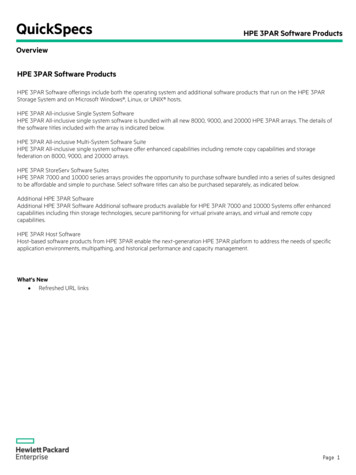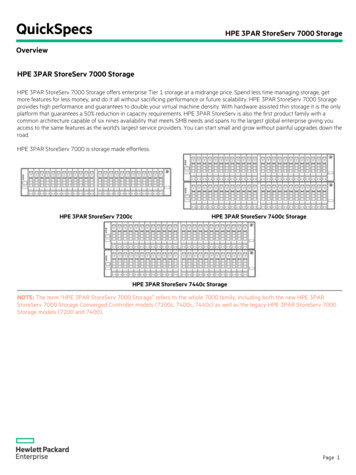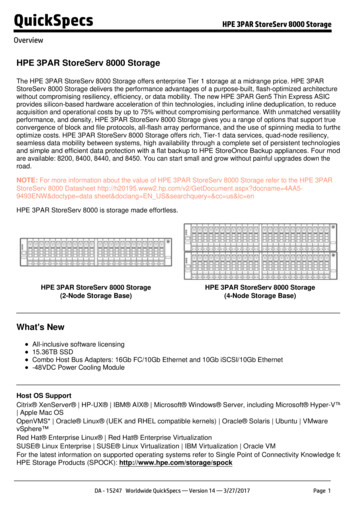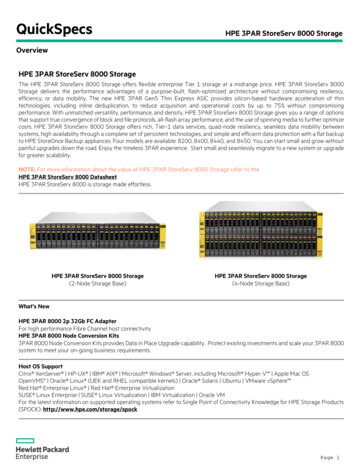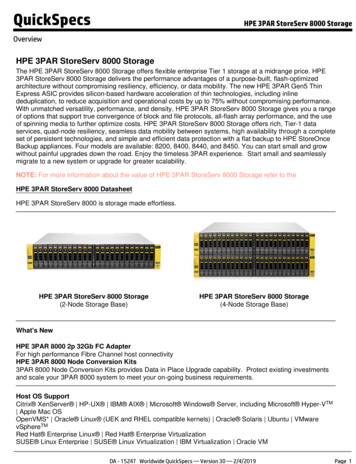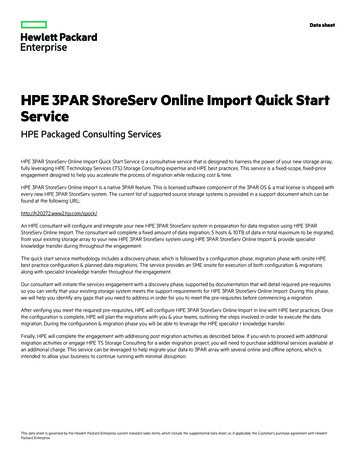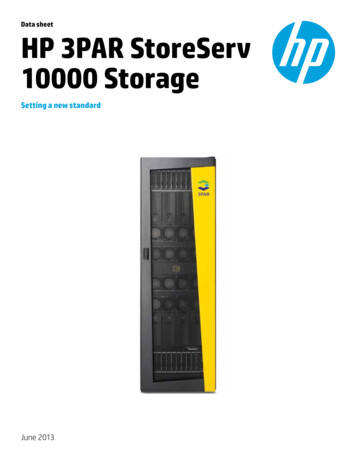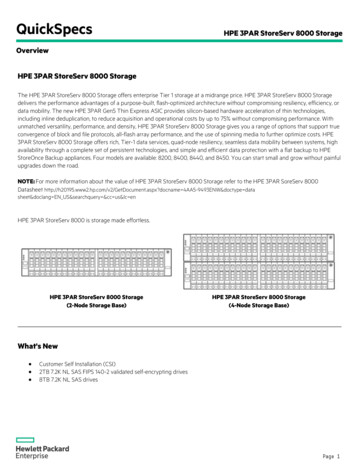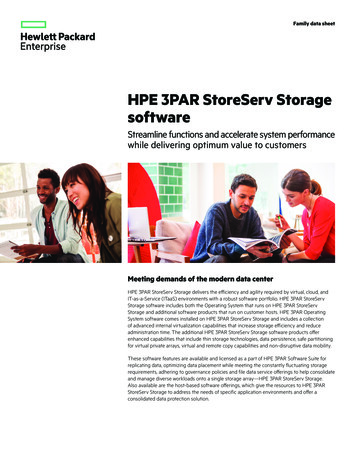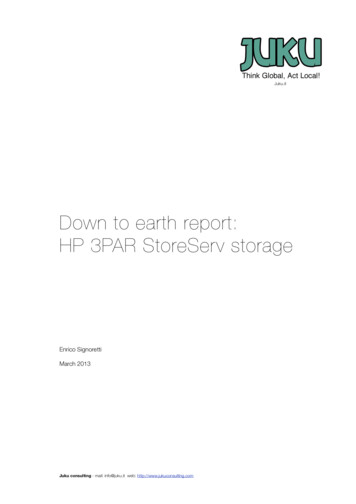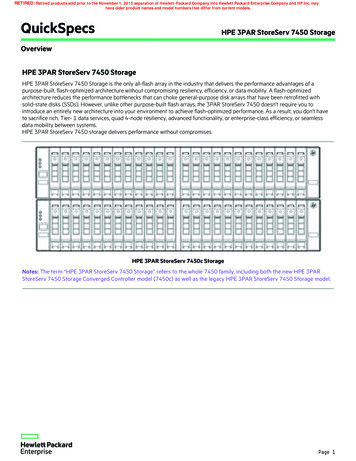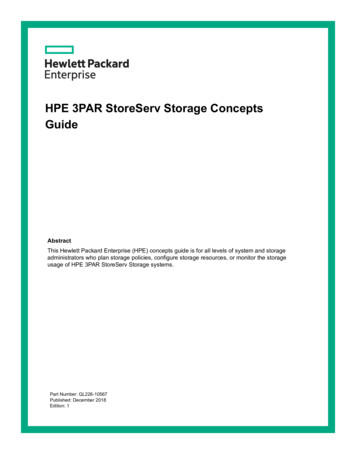
Transcription
HPE 3PAR StoreServ Storage ConceptsGuideAbstractThis Hewlett Packard Enterprise (HPE) concepts guide is for all levels of system and storageadministrators who plan storage policies, configure storage resources, or monitor the storageusage of HPE 3PAR StoreServ Storage systems.Part Number: QL226-10567Published: December 2018Edition: 1
Copyright 2007-2018 Hewlett Packard Enterprise Development LPNoticesThe information contained herein is subject to change without notice. The only warranties for Hewlett PackardEnterprise products and services are set forth in the express warranty statements accompanying suchproducts and services. Nothing herein should be construed as constituting an additional warranty. HewlettPackard Enterprise shall not be liable for technical or editorial errors or omissions contained herein.Confidential computer software. Valid license from Hewlett Packard Enterprise required for possession, use,or copying. Consistent with FAR 12.211 and 12.212, Commercial Computer Software, Computer SoftwareDocumentation, and Technical Data for Commercial Items are licensed to the U.S. Government undervendor's standard commercial license.Links to third-party websites take you outside the Hewlett Packard Enterprise website. Hewlett PackardEnterprise has no control over and is not responsible for information outside the Hewlett Packard Enterprisewebsite.AcknowledgmentsGoogle is a trademark of Google Inc.Linux is a trademark of Linus Torvalds in the U.S. and other countries.Microsoft , Windows , and Hyper-V are either registered trademarks or trademarks of Microsoft Corporationin the United States and/or other countries.Mozilla and Firefox are trademarks of Mozilla Incorporated.Red Hat is a trademark of Red Hat, Inc. in the United States and other countries.UNIX is a registered trademark of The Open Group.VMware , VMware ESX , VMware ESXi , VMware vCenter , and VMware vSphere are U.S. registeredtrademarks of VMware, Inc.
ContentsHPE 3PAR StoreServ Storage.8Overview.8Physical Disks (PD). 9Chunklets.9Logical Disks (LD). 9Common Provisioning Groups (CPG). 9Virtual Volumes (VV). 9Fully Provisioned Virtual Volumes (FPVV).10Thinly Provisioned Virtual Volumes (TPVV).10Physical Copies. 10Virtual Copy Snapshots. 10Logical Unit Number. 11HPE 3PAR software licensing.12Types of HPE 3PAR All-inclusive Software License.12All-inclusive Single-System HPE 3PAR Software License. 12HPE 3PAR All-inclusive Multi-System Software License.13Data at Rest Encryption software license. 14HPE 3PAR All-inclusive Software Matrix. 14HPE 3PAR Transition License (Old to New).15HPE 3PAR StoreServ storage system users. 17User account roles.17Local user authentication and authorization. 18LDAP user authentication and authorization. 18Domain user access. 18Strong passwords.18Time-based passwords.19Encrypted ciphertext passwords.19Ciphertext exports.19Ciphertext password modification. 19Password mode. 20Two-factor authentication for StoreServ Management Console. 20Performing password tasks.21Exporting ciphertext.21Changing the ciphertext password. 21Setting or changing the password mode. 21Lightweight Directory Access Protocol.22Active Directory. 22OpenLDAP. 22Red Hat Directory Server. 22LDAP users. 22LDAP server data organization.233
LDAP and Virtual Domains.23LDAP authentication and authorization. 23LDAP authentication. 24Simple binding. 24SASL binding. 24LDAP authorization.24Authorization on systems using virtual domains.25HPE 3PAR Virtual Domains.26Domain types.26Users and domain rights.27Object and domain association rules.27Default and current domains. 27Ports and hosts.28About ports. 28Active and inactive hosts. 29Host addition and removal.29Legacy host personas. 29Host Explorer Software agent.29Port and host guidelines.31Port target, initiator, and peer modes. 31Host persona management. 31Chunklets. 34Physical disk chunklets.34Spare chunklets.34Logical disks. 36Logical disks and common provisioning groups. 36Logical disk types. 36RAID types. 37RAID 0. 37RAID 1 and RAID 10.37RAID 5 and RAID 50.38RAID MP or RAID 6. 39Logical disk size and RAID types. 40Common Provisioning Groups.41CPG precautions, planning, and guidelines. 42Growth increments, warnings, and limits.42Growth increments.42Growth warning.43Growth limit.43System guidelines for creating CPGs.43Volume types associated with CPGs.444
Virtual Volumes. 45Virtual volume types. 45Administrative Volumes. 46Fully Provisioned Virtual Volumes. 46Thinly Provisioned Virtual Volumes (TPVV).46Adaptive Data Reduction (ADR).47Zero Detect. 47Deduplication . 47Compression .48Data Packing . 48Virtual volume online conversion.49Physical copies.49Virtual copy snapshots. 50Virtual copy snapshot relationships. 50Copy-on-write function. 51Copy-of and parent relationships. 52Virtual volumes exportation. 53VLUN templates and active VLUNs.53VLUN template types.53Host sees templates. 53Host set templates. 53Port presents templates. 54Matched set templates.54TPVV warnings and limits.55Reclamation of unused space. 56Reclamation of unmapped LD space from CPGs.56Reclamation of unmapped LD space from volumes.57Automatic reclamation of unused snapshot space from volumes. 57Manual reclamation of unused snapshot space from volumes.57Deleted volume snapshot space. 57Logical disks and chunklet initialization. 57Enhanced HPE 3PAR storage software. 58HPE 3PAR File Persona.58HPE 3PAR Thin Express ASIC.59HPE 3PAR Remote Copy. 59HPE 3PAR Dynamic Optimization . 59HPE 3PAR Adaptive Flash Cache.60HPE 3PAR Adaptive Flash Cache support for NVMe Storage Class Memory Module. 61HPE 3PAR System Tuner.61HPE 3PAR Thin Conversion.62Assessment. 62Data preparation. 62Unused space zeroing. 62Physical copy creation. 63HPE 3PAR Thin Persistence. 63HPE 3PAR Thin Copy Reclamation.63HPE 3PAR Virtual Lock. 63HPE 3PAR Adaptive Optimization. 635
HPE 3PAR Peer Motion software. 64Data encryption. 64Priority Optimization. 66Virtual Volume Sets. 66Quality of service rules. 67Mode of operation. 67QoS rule minimum and maximum. 68QoS rule actions. 68Overlapping QoS rules. 68Minimum QoS settings.69QoS on copied volumes.69HPE 3PAR StoreServ Storage hardware.70Identifying HPE 3PAR StoreServ Storage system components. 70HPE 3PAR StoreServ Storage hardware components.70Physical drive.70Drive Enclosure. 71Controller Node.71Service Processor 5.0.71Physical Service Processor (PSP).71Virtual Service Processor (VSP). 71VM Vision/VM Integration. 72Power Distribution Unit. 72I/O Module. 72HPE 3PAR StoreServ Storage models.72HPE 3PAR StoreServ 7000 Storage.74HPE 3PAR StoreServ 8000 Storage.74HPE 3PAR StoreServ 9000 Storage.74HPE 3PAR StoreServ 10000 Storage.75HPE 3PAR StoreServ 20000 Storage.75HPE 3PAR SNMP infrastructure. 76About SNMP.76HPE 3PAR SNMP agent guidelines. 77SNMP managers. 77Standard compliance.77Supported MIBs.77MIB-II. 78Exposed objects. 78System Description. 78System Object ID. 79System Up Time.79System Contact Information.79System Name. 79System Location. 79HPE 3PAR MIB.80Severity levels of the alert state.85Alert state values. 86alertNotify traps.86HPE 3PAR Common Information Model API. 886
SMI-S.88WBEM initiative. 88HPE 3PAR CIM support. 89Standard compliance. 89SMI-S profiles. 89Supported extensions. 89CIM indications. 89Comparing HPE 3PAR to EVA terms.90Support and other resources. 92Accessing Hewlett Packard Enterprise Support. 92Accessing updates. 92Customer self repair. 93Remote support. 93Warranty information. 93Regulatory information. 94Documentation feedback.94Glossary. 95A. 95B. 96C. 96D. 97E. 98F. 98G.99H. 99I.100J.101K. 101L.101M.101N. 102O.103P. 103Q.104R. 104S.
HPE 3PAR StoreServ Storage systems support the following RAID types: RAID 0 RAID 10 (RAID 1) RAID 50 (RAID 5) RAID MP (Multi-Parity) or RAID 6 More information Logical disks on page 36 Common Provisioning Groups (CPG)
